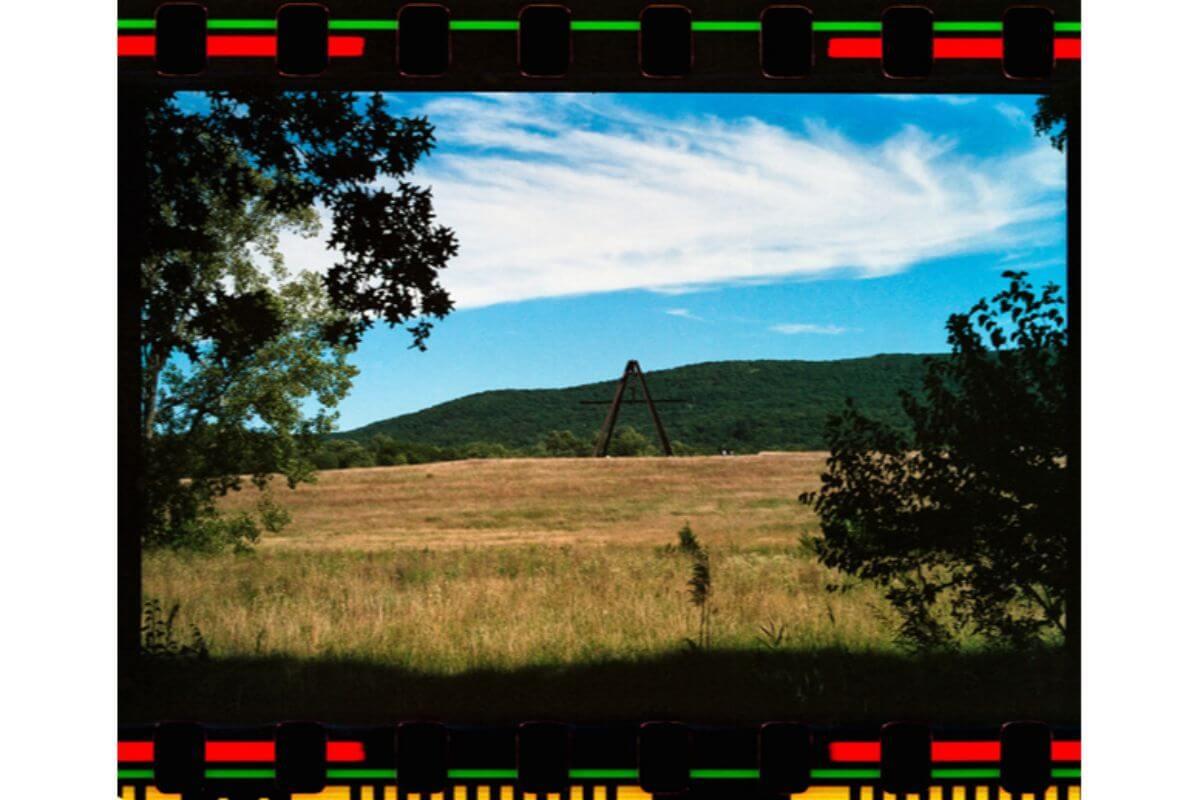35mm color film photographs by Piotr Pillardy
(Developed & scanned at Exposure Therapy in Brooklyn)
Just a short drive or train ride from the city is Storm King Art Center (more often solely referred to as Storm King, named after the nearby mountain). Set in an idyllic landscape, this art center acts as the perfect and prescient solution to our ongoing need for social distancing while trying to enjoy art in a public setting,
[slideshow_deploy id=’12067′]
With its blend of “pastoral romanticism” (to borrow a phrase from Schitt’s Creek’s Moira Rose) and industrial grit, the sculpture garden and its 500 acres of pristinely manicured/naturalistic grounds are ripe for exploration while allowing visitors to keep their distance from one another. The experience is enhanced by taking in the equally sublime beauty of the Hudson Valley in the prime of autumn with its cascading changing leaves.
I recently made a trip to Storm King over the warm Labor Day weekend and was blown away as always, more so as I had not been able to physically experience art in so many months. It was my third trip to the sculpture garden, having visited in 2012 and 2014. Storm King has adjusted to the pandemic with timed ticket reservations and a drive through check in operation wherein the tickets are scanned on your phone. After that you are clear to enter the main sculpture garden. While the house, which usually contains additional exhibitions, is closed due to the pandemic, the rest of the grounds are open. For me, the beauty of Storm King is being able to wander around its vast expanse and continuously have chance encounters with amazing pieces of art. Having already explored a fair portion of the grounds on prior visits, this past experience was one of running into old friends I hadn’t seen in a while.
The sculpture garden consists of four distinct areas: The Meadows, Museum Hill, the North Woods, and the South Fields, which arguably houses the “greatest hits” at the center. For this visit, I started through this main portion of the grounds. The South Fields, a wide open landscaped prairie punctuated by immense raw industrial forms, is a good introductory point, as it involves the most walking between art objects, which can seem more arduous after you’ve spent time traversing the grounds. Some of the sculptures for which Storm King is most famous are located here, such as Mark di Suvero’s Pyramidian (1987/1998), among numerous other large scale works by di Suvero and others. The towering form, along with the many others in this part of the garden, evoke such a sense of grandeur, which can’t help but remind the viewer of their infinitesimal place within the universe.
To the right of the South Fields is Bunny Road, a picturesque tree lined street, a familiar location to fans of the Netflix series Master of None. If you take this road, you will stumble upon possibly one of my favorite sculptures on the grounds, sculptor Magdalena Abakanowicz’s Sarcophagi in Glass Houses (1989), a series of sculptures incased in glass and wooden enclosures. In a completely different location on the grounds than my last visit, the series shines in its new home to the right of Bunny Road, framed in a section of greenery that helps create a more intimate connection with the objects than the wide-open landscape of the South Fields. The works themselves, created from repurposed turbines and machinery from near Lyon, France, were seen by Abakanowicz as analogous to human bellies. She then created the enclosures to protect these vulnerable and powerful forms.
Continuing down the road is a little-known boat/sculpture by well-known artist Roy Lichenstein entitled Mermaid from 1994. With the boat mounted to an island surrounded by a small moat of water encircled by trees, this is another instance in which the curation really helps create a unique experience for the viewer. The bright blue and yellow hues of the mermaid, done in Lichenstein’s signature graphic comic book style, cut through the natural scenery. The functioning sail boat (named Young America) itself was painted by Rhode Island School of Design students based on Lichenstein’s plans and, in its past life, also raced in the 1995 America’s Cup.
From this section, I made my way back around in a loop to the western portion of the garden. On the way there, I encountered some more exciting pieces, namely Alyson Shotz’s Mirror Fence, created in 2003 and refabricated in 2014. A popular destination for taking photographs due to its reality-displacing reflection, I too couldn’t resist snapping a shot.
Leaving Museum Hill, I entered the next section of the garden, also containing seminal works, known as the North Woods. Some of my favorites here included Alice Aycock’s Three-Fold Manifestation II, originally created in 1987 and later on refabricated in 2006. As intricate as the name would suggest, the piece consists of an M.C. Escher-eque combination of towering white forms that replicate themselves thrice. This piece, with its bold white color, creates a stark contrast with the lush, green trees behind it. Other works of note here include Alexander Liberman’s Adam (1970), an abstract monumental crimson geometric form. The masterful curation of the piece atop a hill further heightens its scale and frames it beautifully in the landscape.
The artistic process for the work is almost as interesting as the sculpture itself: Liberman would have an assistant position various elements with a crane and temporarily weld them together, which Liberman would then photograph, print, cut out, and arrange until he arrived at the right configuration. Interestingly, when the sculpture was first exhibited outside the Corcoran Gallery in Washington, DC in 1970, President Richard Nixon objected to it, demanding it be relocated to a less visible location in Haines Point. It then arrived at its current location in Storm King a few years later.
Down the hill from Adam is another of my Storm King favorites: Menashe Kadishman’s Suspended (1977). This grand industrial work seemingly defies gravity, with its rusty weathering steel, becomes all the more intangible the closer one gets to it. The curation, atop one of two adjacent hilltops (the other occupied by Adam), helps draw your eye to its curious form even from far away.
These are only a few of the magnificent pieces I saw and cannot begin to describe all of the beauty I witnessed on that day. It is truly an experience I cannot recommend enough, especially as a way to enjoy art seemingly unencumbered by the modern predicament in which we find ourselves.
Open until December 13th, Storm King is well worth the trip for to satisfy your urge for both fall foliage and larger than life sculptures, all in the span of a single weekend jaunt!
1 – Mark di Suvero’s Pyramidian (1987/1998)
2 – Magdalena Abakanowicz’s Sarcophagi in Glass Houses (1989)
3 Roy Lichtenstein’s Mermaid (1994)
4 Alyson Shotz’s Mirror Fence, (2003; refabricated in 2014)
5 – Alice Aycock’s Three-Fold Manifestation II, (1987, refabricated in 2006)
6 – Alexander Liberman’s Adam (1970)
7 – Menashe Kadishman’s Suspended (1977) with Alexander Liberman’s Adam (1970) visible in the distance
Author
-

Piotr Pillardy is an arts/music writer for the Red Hook Star-Revue. He received a BA in History of Art and History from Cornell University and lives in Brooklyn
View all posts
Piotr Pillardy is an arts/music writer for the Red Hook Star-Revue. He received a BA in History of Art and History from Cornell University and lives in Brooklyn











One Comment
Pingback: "Brooklyn Art" – Google News: Where Art is (Storm) King – The Red Hook Star-Revue | The Brooklyn News